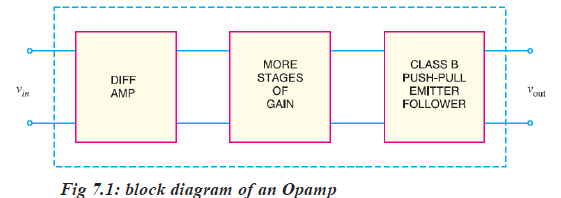- Fig. 7.1 shows the block diagram of an operational amplifier. Note that OP-Amp is a multistage amplifier.
- The key electronic circuit in an OP-Amp is the differential amplifier. A differential amplifier (DA) can accept two input signals and amplifies the difference between these two input signals.

The following points may be noted about operational amplifiers (OP-Amps):
(i) The input stage of an OP-Amp is a differential amplifier (DA) and the output stage is typically a class B push-pull emitter follower.
(ii) The internal stages of an OP-Amp are direct-coupled i.e., no coupling capacitors are used.
(iii) The direct coupling allows the OP-Amp to amplify d.c. as well as a.c. signals.
(iv) An OP-Amp has very high input impedance (ideally infinite) and very low output impedance (ideally zero). The effect of high input impedance is that the amplifier will draw a very small current (ideally zero) from the signal source. The effect of very low output impedance is that the amplifier will provide a constant output voltage independent of current drawn from the source.
(v) An OP-Amp has very high open-loop voltage gain (ideally infinite); typically more than 200,000. Nb. The gain of an OP-Amp without feedback circuit is called open-loop gain. The gain of an OP-Amp with feedback circuit is called closed-loop gain
(vi) The OP-Amps are almost always operated with negative feedback. It is because the openloop voltage gain of these amplifiers is very high and we can sacrifice the gain to achieve the advantages of negative feedback including large bandwidth (BW) and gain stability.
Wilfykil answered the question on
August 15, 2019 at 13:12